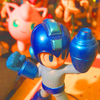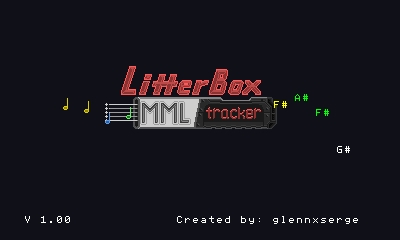It even has an autosave feature? Neat
Edit seriously though this is really amazing and polished
Replying to: jamieyello
jamieyelloIt even has an autosave feature? Neat
Edit seriously though this is really amazing and polished
Yeppers, when you boot up the program there is a restore button at the bottom if it finds a backup. The application stores all the needed persistent song data in the prg slots, so it survives program termination and can be retrieved later.
EDIT: But to be clear, it's a fail-safe, it's a better idea to actually use the Save button in the application
Hi, I tried to use it on my O3DS but it doesn't work well. You forgot to use gpage before and after rendering the gui to draw everything in one step.
Replying to: raimondz
raimondzHi, I tried to use it on my O3DS but it doesn't work well. You forgot to use gpage before and after rendering the gui to draw everything in one step.
Oh it's unoptimized on O3DS? Darn, I'll have to wait and try this. This is one of the few SB programs I've actually been anticipating.
It looks fantastic though! I was expecting something more like FastTracker II or Famitracker but this I think is more fitting for the nature of MML itself. Can you even call this a tracker?
If you need any help optimizing it for O3DS I can get your back.
This looks sweet! I've been using NCF-Museq, but this looks like an improvement over that! Does it support portamento (_) or note connections (&) by chance? That's the main thing missing in NCF-Museq that I want to work with.
Replying to: mystman12
mystman12This looks sweet! I've been using NCF-Museq, but this looks like an improvement over that! Does it support portamento (_) or note connections (&) by chance? That's the main thing missing in NCF-Museq that I want to work with.
Oh yeah, definitely not working on O3DS! It's flickering like crazy!
Replying to: mystman12
mystman12This looks sweet! I've been using NCF-Museq, but this looks like an improvement over that! Does it support portamento (_) or note connections (&) by chance? That's the main thing missing in NCF-Museq that I want to work with.
Is it slow or just really flickery? Depends on how much optimizing he might need
Needs more cowbell!
Can't wait to have an o3ds optimized version! This is going to be one handy tool!
Replying to: raimondz
raimondzHi, I tried to use it on my O3DS but it doesn't work well. You forgot to use gpage before and after rendering the gui to draw everything in one step.
Hi Raimondz, I've only used this on my N3DS, so I'm unaware of such problems. I'll look into the gpage issue, but I might need feedback from O3DS users. Thanks for pointing the issue out!
Replying to: mystman12
mystman12This looks sweet! I've been using NCF-Museq, but this looks like an improvement over that! Does it support portamento (_) or note connections (&) by chance? That's the main thing missing in NCF-Museq that I want to work with.
Mystman12, it supports '_' for portamento connections, and '&' for automatically tieing notes that cross beat boundaries
Replying to: raimondz
raimondzHi, I tried to use it on my O3DS but it doesn't work well. You forgot to use gpage before and after rendering the gui to draw everything in one step.
Depends on how your code is written, but I could probably give you a gpage buffer in 5 minutes. It's very easy and lightweight and should remove the flicker. Making it run any faster is more of a challenge.
Replying to: raimondz
raimondzHi, I tried to use it on my O3DS but it doesn't work well. You forgot to use gpage before and after rendering the gui to draw everything in one step.
Hi slackerSnail, if you can give me an example of where that's used, I'm sure I can patch it in quickly tonight.
There are plenty of other areas I can optimize as well in how the interface is drawn, I just didn't realize it was a problem until now. Sorry to all the O3DS users (>_<)
Replying to: raimondz
raimondzHi, I tried to use it on my O3DS but it doesn't work well. You forgot to use gpage before and after rendering the gui to draw everything in one step.
Basically here's the problem, you go into the application after making a project, and flicker galore; I can't do anything. :P I'll probably watch this page to see when this is fixed, because it looks impressive; oh boo us O3DS users

Replying to: raimondz
raimondzHi, I tried to use it on my O3DS but it doesn't work well. You forgot to use gpage before and after rendering the gui to draw everything in one step.
Thanks slackerSnail, that's crystal clear. I remember using double buffering (and quadbuffering for 3d displays) in other languages, so your explanation makes sense. However, the GPAGE command is a bit odd to me. It seems like it relates strictly to the graphics page. Are the BG and Sprite layers folded into the graphics page at that point? Or will I need to swap those individually as well?
Right now I'm using all 6 pages (3 on top, 3 on bottom) for drawing the UI, however, both the BG and Sprite layers use the same tile set, so I could save a page by setting the BG and Sprites to the same one. The top screen I can optimize enough by only drawing it once at the beginning of a application state change as the information is static (outside of the timer during playback). Between those two things, I think I can cut down quite a bit of churn. The actual application data processing should be fairly inexpensive (just iterating over some arrays, and bitfield masking, etc..), but I'll run some timing tests to double check that I'm not wasting cycles there. Thanks again for your help.
Very nice! This is just what I was looking for. Now I don't have to develop one for myself!
Thank you! :D
Replying to: raimondz
raimondzHi, I tried to use it on my O3DS but it doesn't work well. You forgot to use gpage before and after rendering the gui to draw everything in one step.
Do you do a lot of redrawing on the BG and sprite pages? I was under the impression that the flicker was just from redrawing a lot of GRP graphics on screen.
EDIT: NOW that I run it, I notice you're redrawing pretty much everything per frame. That's not something you should do. Much of this UI could be either drawn only when you need to change it, or be sprites or BG layer objects. You may need to do a lot of rewrites to the way you do the GUI.
Replying to: raimondz
raimondzHi, I tried to use it on my O3DS but it doesn't work well. You forgot to use gpage before and after rendering the gui to draw everything in one step.
Very little is drawn to the graphics page, just some text on the top screen, where the console print doesn't give the pixel precision placement I needed. On the bottom screen I draw a line timeline during playback, and I think that's about it.
However, I am setting the BG and Sprites on every frame, and I plan on optimizing that with dirty flags that only draw when specific things change.
